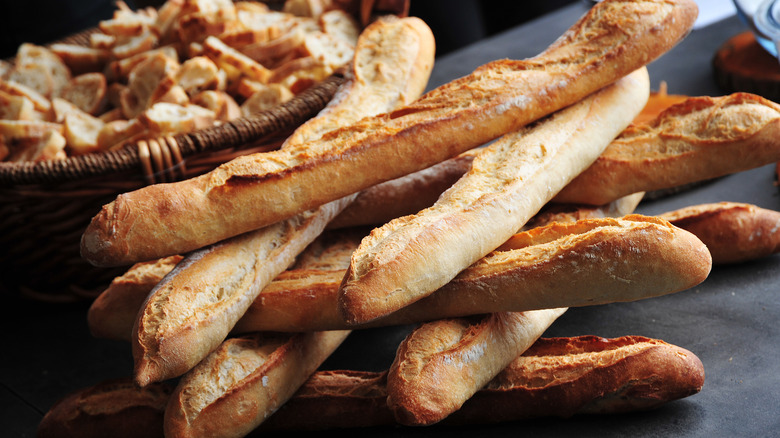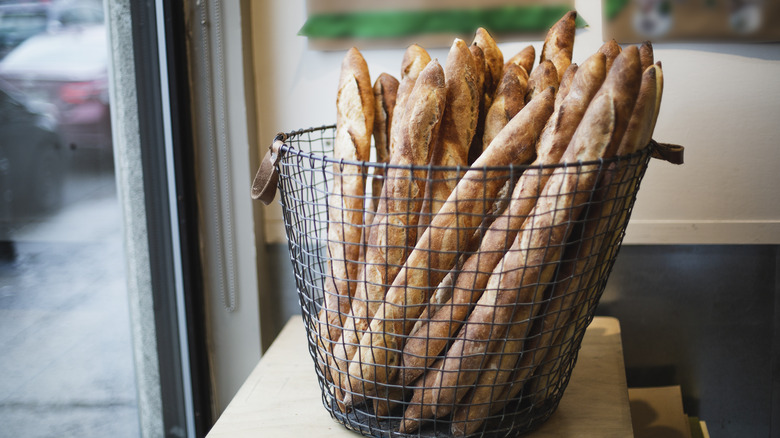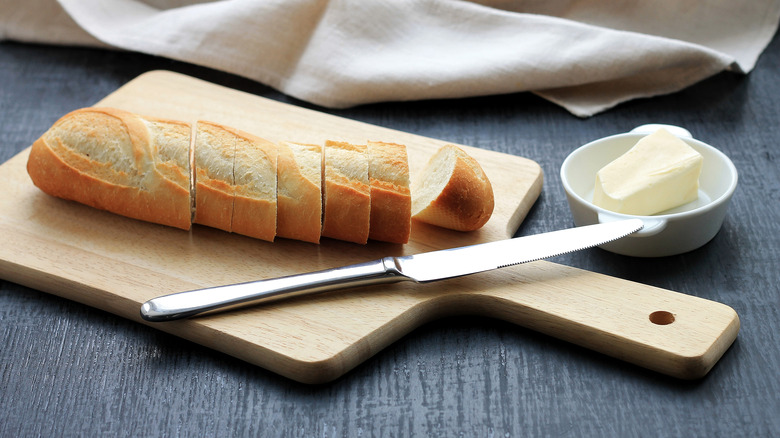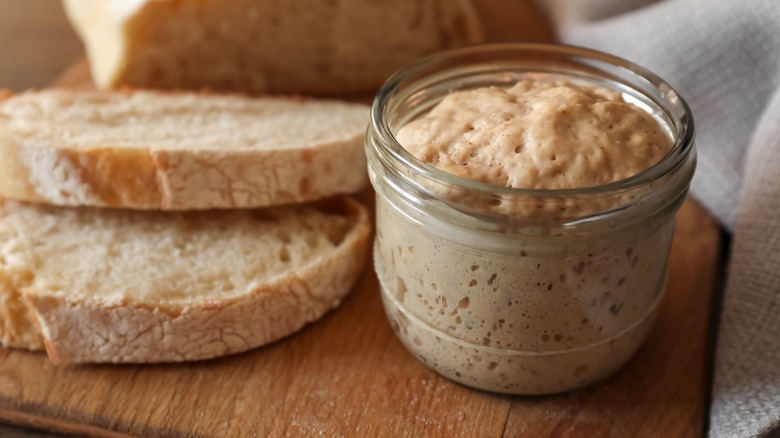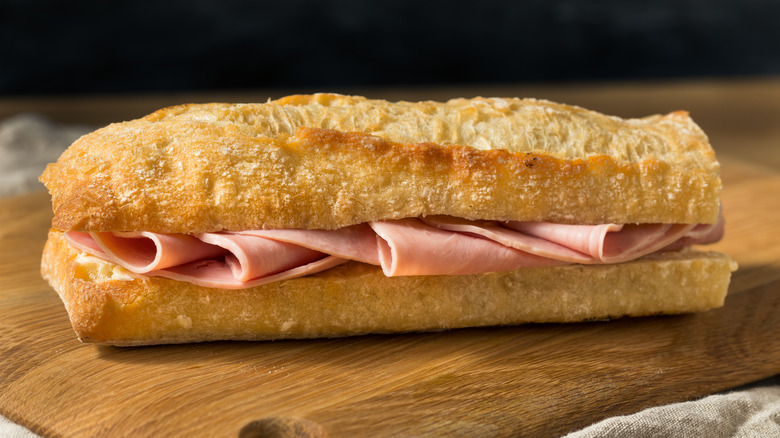French Baguette Vs Sourdough Baguette: What's The Difference Between Breads?
We all know that the French take their bread and their food labeling very seriously, so they would be the ones to get a little obsessive over the difference between a classic baguette and a sourdough one. There are plenty of different delicious French breads, but none of them are quite as iconic as the baguette. To outsiders, the long, crusty loaves playfully poking out of handbags around Paris are to France what pasta is to Italy or tacos to Mexico. An oversimplification of a wildly diverse cuisine, for sure, but also something that represents a very real commitment to craft, quality, and fresh ingredients.
Baguettes are famous and beloved enough that UNESCO (the organization that helps protect heritage sites like Machu Picchu and the Colosseum) even declared the French baguette to be an intangible part of French and world cultural heritage. That's quite an honor for a loaf of bread. So don't go calling a French baguette sourdough without knowing what you're talking about.
As might be inferred from the name, a sourdough baguette is similar in form to the classic French version, but the small differences between the two actually produce pretty unique flavors. The use of sourdough is fundamentally different from the processes used to make a French baguette and, thus, involves a different preparation too. As traditional as it may seem, a French baguette is actually a pretty modern form of bread, and its essential components didn't exist until long after sourdough had been made for centuries.
What is a French baguette?
Bread of all kinds is a pretty magical example of the science of baking, and the simplicity of what goes into French baguettes is pretty stunning considering the result. Your classic baguette is just four ingredients: flour, water, salt, and yeast. It's those first and last ingredients that really made the current version of the baguette possible.
Baguettes didn't come about until the 19th century and didn't get their current form and name until around 1920. There is no specific known origin story of the baguette — it's been credited to Napoleon or even as the accidental creation of French labor laws, but the most important thing is that the baguette is a populist creation making quality white bread available to the masses. This came about because of modern industrial wheat milling, which made white flour that was formerly reserved for the upper classes much cheaper, as well as the invention of modern commercial yeast in the middle 19th century.
So bakers yeast, white flour, water, and salt are what make a French baguette. Beyond that, it is all in the baker's skill and the shaping of the bread into its classic torpedo form. French baguettes are lean breads that use high-protein flour to produce a crispy crust and airy, irregular interior. All the flavor comes from the limited salt and the fermentation and rising process, which produces the signature yeasty taste. It's simple, but mess with it at all, and it's not technically a French baguette anymore.
What is a sourdough baguette?
A sourdough baguette is just bread in the French baguette form — and ideally with the same crispy, airy texture — but made with a sourdough starter instead of baker's yeast. Sourdough is also known as naturally leavened bread, because historically, sourdough is pretty much how all bread got its rising power before the invention of commercial yeast. This is because sourdough is a way of capturing wild yeast to help dough rise. There is already wild yeast sitting on your flour, so when you add water the yeast can start chowing down and producing carbon dioxide air bubbles, the same process that happens with commercial yeast.
Sourdough-leavened baguettes and bread are less predictable than ones that use commercial yeast because you have less control, but wild yeast also produces lactic and acetic acids, which give all sourdough products their natural tangy flavor. Making sourdough baguettes means waking up a premade sourdough starter and mixing some of it into dough in place of commercial yeast. You also must compensate for the water and flour that is already in the starter when weighing out ingredients. Finally, using sourdough starter means that your baguette will take longer to rise, making sourdough versions of baguettes more of an overnight affair. However, you can also do a mixture of both to get some of the stronger rising power of commercial yeast with the flavor sourdough.
French baguettes have a less tangy flavor
Using commercial yeast means a French baguette won't have the distinct "sour" flavor of sourdough, but that doesn't mean it's bland. French baguettes can be raised in a few hours, but good versions are often left to cold-raise overnight, which extends the fermentation process and creates more unique tastes. Coming from white flour, French baguettes will have a light sweetness, the yeasty taste of fresh white bread, and some additional nutty or fermented notes from the rise. French white flour also has a slightly higher amount of bran and germ than American flour, which can add some mild whole wheat flavor to the bread. Bakers in the U.S. can mimic this by making their flour mixture about 5% whole wheat.
Sourdough baguettes will have the acidic tang that the bread is known for, which can add to the complexity of the bread or overwhelm it, depending on how it's handled and also the personal preference of the baker. Some people love really strong sourdough, even if that's not the classic taste of a baguette. Even within the simple recipe of a sourdough baguette, there is a lot that can be done to decrease or increase the sour flavor to your preference. Letting your sourdough starter "ripen" by waiting longer before you add it to the bread will make it extra sour. Using some whole grains in the mix or rising at a warmer temperature will also encourage the acids that produce sourdough's flavor.
Both French and sourdough baguettes can be used in various baguette dishes
Baguettes are as multi-purpose as any loaf of bread, but the most common way they are eaten in France is as a base for spreading toppings. This could be as simple as butter or jam for breakfast but may also be pâté, other savory spreads, and toppings like hazelnut or honey for a dessert. Of course, baguettes are also made into sandwiches, which often feature simple, high-quality ingredients, like good ham and cheese with butter (a jambon beurre) or pan bagnat featuring the ingredients of a niçoise salad in sandwich form. The crispy texture of a baguette is also ideal for dipping in soups and stews. Try one with a creamy bisque to make it a little more filling, or a comforting French onion soup.
Sourdough baguettes can be used in much the same way, you'll just need to make a personal call on how the tangy taste pairs with classic baguette uses. On a ham sandwich, it would provide a great, sharp counterpoint to the rich meat and cheese, but you might not like it as much with some of the sweeter dessert uses. As a stronger flavor it will also stand up to more ingredients, so you can try some more loaded American-style sandwiches and heartier fillings like roast beef. In the end, baguettes are about that perfect textural contrast and the joy of fresh, homemade bread. The differences will only matter so much.
